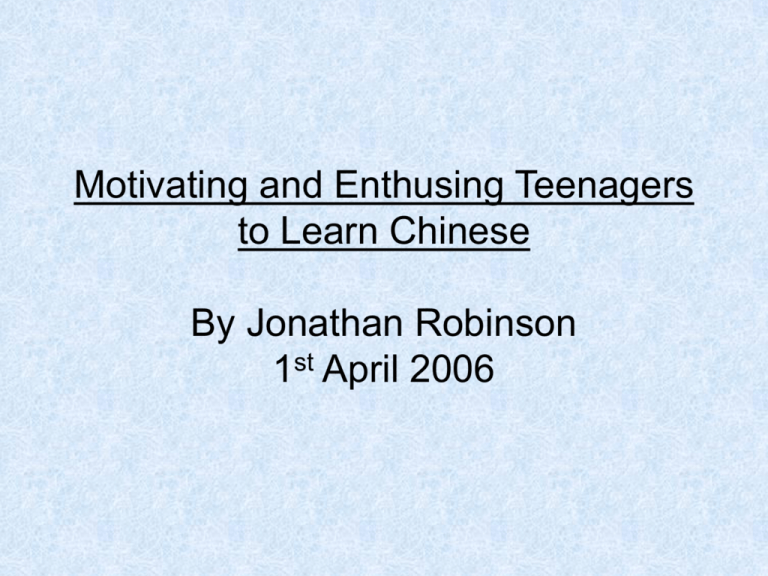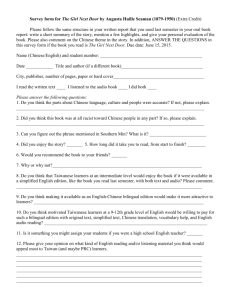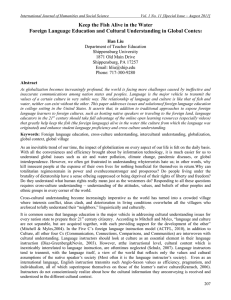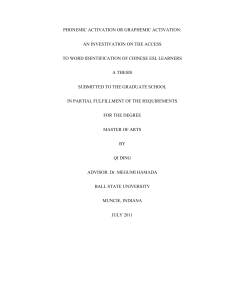Lecture 1 - Life Learning Cloud
advertisement

Motivating and Enthusing Teenagers to Learn Chinese By Jonathan Robinson 1st April 2006 This lecture will look at … • Promoting the study of Chinese to older children of Chinese • The important role of personal motivation and ingenuity of the teacher • How to motivate teenagers to learn the language in and beyond the classroom On Promoting the Study of Chinese • • • • • Number of speakers: well over 1.3 billion Crouching Tiger: booming economy Hidden Dragon: political heavyweight Tourism: mutually beneficial Culture: art, philosophy, alternative medicine, cinema, martial arts, history • Support: Chinese government promotion • Language: a growing Western fascination and a cultural rediscovery for the BBC How to Promote Chinese at School 1. Set up an extracurricular language club 2. Survey the students’ interests before and after taster language sessions 3. Organise cultural awareness days at key times of the Chinese year with cross-curricular collaboration 4. Research funding opportunities and timetabling possibilities for classes 5. Present a realistic plan to HoD and SLT 6. Take advantage of the Language Ladder 7. Organise international trips / guest speakers / links with schools in China The important role of personal motivation and ingenuity of the teacher 1. 2. 3. 4. 5. What is my experience of learning Chinese? Why am I a Chinese teacher? What are my goals as a teacher? What are my teaching priorities? How does my teaching and learning style affect my motivation? 6. How motivated am I to prepare my lessons thoroughly and evaluate them successfully? 7. How do external factors affect my motivation to teach effectively in any given lesson? We learn … • • • • • • • 10% of what we read 20% of what we hear 30% of what we see 50% of what we see and hear 70% of what we discuss with others 80% of what we personally experience 90% of what we teach to someone else What type of learner am I? When learning a new language do you prefer to … 1. 2. 3. 4. 5. 6. 7. 8. 9. 10. 11. 12. 13. 14. 15. Use mind maps to brainstorm a topic when revising for a test? Record your voice onto a tape to improve your pronunciation? Act out role plays with your friends? Put up posters as aides-mémoir? Go over the key points of a lesson with someone else? Learn by doing something creative or making something? Draw diagrams and pictures to help you acquire new vocabulary and structures? Get someone to test you / ask you questions? Keep vocabulary notes on small memory flashcards? Use TV and internet resources regularly to supplement your text book? Enjoy giving presentations / speeches in the target language? Create models rather than draw posters? Use mnemonics to memorise vocabulary / grammatical rules? Learn from songs, music and rhymes? Move around rather than sit in one place for a whole lesson? 3 Types of Learner Visual Learners Auditory Learners Kinesthetic Learners 1, 4, 7, 10, 13 2, 5, 8, 11, 14 3, 6, 9, 12, 15 As a teacher I need to be not only aware of my own preferred learning style, but of the various learning styles of my students and cater to everyone’s needs accordingly. A variety of learning style opportunities in each lesson and over the course of a unit of work is essential and should be included in the SoW for an y course . How to motivate teenagers to learn the language in and beyond the classroom 1. Don’t be discouraged! Motivation will rise and fall over the duration of the course. Motivation Time 2. Tackle the things you can control Games that Motivate • • • • • • • • • • • • • • • • • Listen and eliminate Dictations Spot the mistakes 20 questions Role plays Find someone who … Memory games Charades Cocktail party Board games / card games / murder games Graded stories Flashcard games Making longer and longer sentences Families Bingo Connect 4 Stop thief! Motivation Flow Diagram EXPERIENCE OF SUCCESS PRAISE REINFORCEMENT STUDENT’S SELF-BELIEF MOTIVATION 3. Develop strategies for dealing with the things you cannot easily control Summary of Motivating Learners • • • • • • Physical surroundings Body language Rewards and Sanctions Marking and Assessment Planning, Preparation, Teaching Classroom Activities








